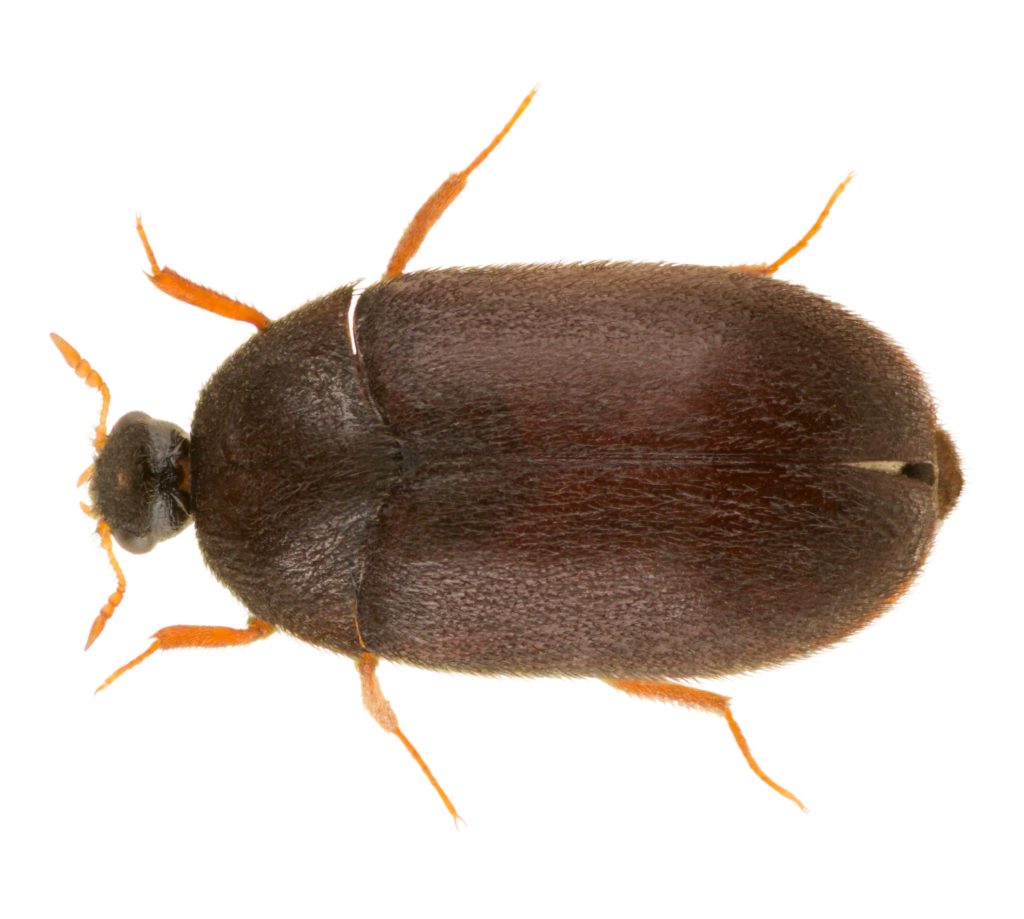Dermestid Beetles for Taxidermy: Best Way to Clean Bones for Taxidermists
When most people think about beetles, they regard them as pests. These insects get into our home, hide out in dark corners, and eat everything from hair, wool, flour, and grains.
However, dermestid beetles also eat the flesh from dead animals, and for this reason, they are one of the most valuable resources taxidermists have access to through reputable sellers.

Attagenus brunneus is a carpet beetle in the family Dermestidae. Dorsal view of isolated skin beetle on white background.
There are two main ways for stripping flesh from the bones of taxidermy mounts: boiling the bones in water and dermestid beetles. In fact, virtually all experienced taxidermists, such as the ones that work for museums and universities, use dermestid beetles due to a number of reasons, while novice taxidermists are slowly starting to learn that boiling is not the best method.
Why use Dermestid Beetles for Taxidermy?
Dermestid beetles for taxidermy are used to process European mounts, shoulder mounts and full-body mounts. The skull is the feature point of any type of mount, and one of the many valuable aspects of utilizing beetles is to preserve the fine details in animal skulls that give the pieces their real value.
As you know, there is a honeycomb-like pattern of intricate little bones within the eye sockets and nasal cavity. When taxidermists boil skulls they run the high risk of deteriorating these delicate little bones that capture the beauty of the work.
On the other hand, dermestid beetles for taxidermy don’t damage these fine bones and help to preserve their integrity by carefully eating the minuscule amounts of flesh left in these crevices.
While the main reason taxidermists prefer dermestid beetles is to clean bones while conserving fine details, there are also some other benefits that make the investment very worthwhile. Boiling bones is messy, and the practice creates a terrible stench.
In addition, boiling usually requires constant supervision, as the process is done outdoors or in an outbuilding with fire or electronic boiling plates as the heat source. Dermestid beetles for taxidermy can be unattended, as the colony is left to do what they do naturally, and no foul odors are released onto your property.
What Do Experienced Taxidermists Look For in Dermestid Beetles?
Once a relatively new taxidermist has realized that dermestid beetles are the preferred option over boiling, one of the many common misconceptions they make is that all beetles are the same.
However, this couldn’t be further from the truth. It is critical to invest in dermestid beetles from a seller that raises healthy colonies.
Kodiak Bones & Bugs Taxidermy is the country’s top-quality dermestid beetle seller, growing healthy colonies that pass a rigorous health check before they are sent to taxidermists in Alaska and all over the United States.
What Are the Top Benefits for Buying Dermestid Beetles?
Dermestid beetles are small insects that have gained popularity in the taxidermy community for their incredible ability to efficiently clean animal skulls, as well as flesh and bones from animal specimens. These beetles offer a range of benefits for those interested in preserving and preparing animal remains, making them an invaluable tool for taxidermists, natural history enthusiasts, and researchers. Here are some of the top benefits of buying dermestid beetles:
- Efficient and Thorough Cleaning: Dermestid beetles are highly efficient at consuming flesh and soft tissue, leaving behind clean bones. They can clean even the most delicate bones without causing damage, ensuring the preservation of intricate details.
- Time-Saving: Compared to traditional maceration methods, dermestid beetles significantly reduce the time required for cleaning skeletons. They work continuously, allowing for faster processing of multiple specimens simultaneously.
- Preservation of Fine Details: Dermestid beetles delicately consume flesh and tissue, preserving fragile structures such as cartilage and tendons. This attention to detail is especially valuable for delicate specimens like birds or small mammals.
- Odor-Free Cleaning: Unlike other methods like boiling or chemical maceration, the beetles work without producing unpleasant odors. This makes them an ideal choice for indoor use or professional settings.
- Reusability: Dermestid beetles can be maintained and reused for multiple cleaning cycles, making them a cost-effective investment. They can be easily housed and bred, ensuring a sustainable supply for ongoing projects.
By harnessing the incredible cleaning power of dermestid flesh-eating beetles, taxidermists and collectors can efficiently and effectively prepare specimens for display or study while ensuring the preservation of intricate anatomical features.

Two skulls that have been cleaned posed on grass.
Buy Healthy Dermestid Beetle Colonies
Some sellers that fail to maintain the standards shared by Kodiak Bones & Bugs, and other reputable dermestid beetle providers, ship colonies that have been infested with fly larvae, mites, and other pests. In order to keep clean dermestid beetle colonies on standby for sale, providers need to house them in the right conditions and monitor their health.
Kodiak uses a new design fortified by a purpose-built, tight building design that keeps all other insects out. We also guarantee that every colony will arrive in perfect health.
Finally, experienced taxidermists seek out dermestid beetle sellers that provide the right environments to house the insects, along with a detailed care guide and phone support, as taxidermists will likely have questions when they receive their first dermestid beetle order.
The most experienced taxidermists use dermestid beetles, and they only work with providers who can ensure that strict quality control is in place, as any invading pest can destroy a colony.
